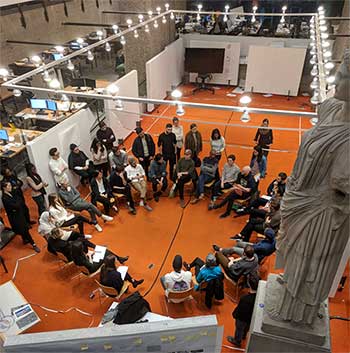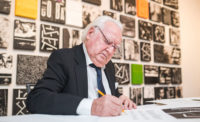When an anonymously sourced spreadsheet alleging inappropriate behavior by men in architecture went viral earlier this year, the national dialogue about sexual harassment had already reached a fever pitch. Gender bias, many argue, is particularly rampant in the profession—a problem illustrated by the archetype of the architect as a lone (white) male genius. It is underscored by the oft-cited statistic that although women and men graduate architecture programs at roughly the same rate in the United States, women represent just 20 percent of licensed professionals, according to a 2018 NCARB report—a figure that dwindles even more among the top leadership positions and when it comes to awards and recognition.
Underwhelmed by top-down initiatives—changes to the AIA Code of Ethics and Professional Conduct and countless roundtable discussions—some people are proposing a drastic, intersectional rethinking of how architecture operates, beginning in the place where many make their first forays into the field.
“To really effect change, we need to focus on culture and where it is solidified—in education,” argued Stella Lee, founding principal of Bureau V, in a New York Times op-ed this October. Earlier this year, Lee was among a handful of women to come forward with allegations of sexual harassment against Richard Meier. “Architectural education is plagued by the mentality that suffering is a necessary part of its practice,” Lee wrote. “The acceptance of suffering easily slips into normalizing sexual misconduct and its suppression as simply part of the practice.”

“Institutional and organizational change is slow, but what’s been happening recently is a really important wake-up call,” says Jennifer Wolch, dean of the College of Environmental Design at the University of California, Berkeley, which recently faced its own allegations of sexual misconduct by a star faculty member. “A lot of the behavior that we find very problematic today was business-as-usual for many, many decades,” Wolch explains, and now the culture at large is in the difficult process of “re-norming.” Much of the official response to sexual misconduct on campuses has been spearheaded by university-wide Title IX teams that take a reactive approach, requiring victims to break the so-called “open secret” problem, and focusing on the adjudication process for abuse allegations. Students, on the other hand, are arguing for a more proactive approach.
“It’s not just these huge cases,” says Cynthia Deng, a cochair of the Women in Design (WiD) group at Harvard’s Graduate School of Design, “There’s a whole spectrum of acts that are systemized forms of discrimination.” The problem can start with microaggressions—commonplace actions that, whether intentionally or not, reveal unconscious bias. (These can range from labeling women in leadership positions “bossy” to using gendered words like “businessman.”) Add to that the current nature of the field, which can leave many vulnerable to misconduct due to a mix of factors that affect myriad professions, including power differentials between professors and students, the intimate environment of the studio, and the pervasive blurring of work/life boundaries.
This month, WiD at Harvard—one of many equity-advocacy groups to form at architecture schools in recent years, from GSAPPXX, Columbia’s chapter of the national women’s group ArchiteXX, to Women in Architecture and Design at Washington University—is hosting a two-day program, A Convergence at the Confluence of Power, Identity, and Design (November 2–3). It features a schedule of talks, workshops, and activities meant to break down conventional ideas about the structure of the industry, from the siloing of design disciplines to macho studio culture—issues that seep out from academia into the profession and society at large. “When we go out and build the world, we perpetuate the emotional violence or the positive experiences we learn,” Deng says. One difficulty in addressing issues of bias and harassment has been simply defining the terms used to discuss unacceptable behavior, which is why so much of the nationwide
One difficulty in addressing issues of bias and harassment has been simply defining the terms used to discuss unacceptable behavior, which is why so much of the nationwide conversation has focused on the worst examples. (Rape is clearly defined by law; bullying and favoritism can be more subjective.) The Equality in Design (EiD) group at the Yale School of Architecture has started an orientation program for incoming students to empower them, as a normal procedure, to call out biased behavior when they see it. It also provides tools for dealing with arguments—false analogies, downplaying, condescending explanations—that can derail these difficult encounters.
This fall, EiD surveyed architecture students, faculty, and alumnae/i from approximately 86 schools around the world, garnering some 779 responses to questions on everything from the role of ego in architecture to comfort with taking on leadership roles on campus. They exhibited the results—which touch on issues of class, race, sexual orientation, and mental health, to name a few, in addition to gender—this October in A Seat at the Table, a show and program series designed as an “inquiry into embedded discrimination and biases that exist at scales large and small within spheres of education.” A key component was providing a forum for further discussion, including a masculinity workshop for male-identifying students to consider their role within the topic of gender discrimination.
“What it really boils down to is being a good person, and providing space that allows for everyone, no matter their background or identity, to take full advantage of the education experience,” says EiD member Rhea Schmid. “How do we make sure that everyone has the opportunity to reach their full potential? By addressing behavior that stops them.”
When some of the most important dialogue surrounding equity, diversity, and inclusion is focused on just that—visibility, representation, and simply starting to talk about the problem—students may have something to teach the educational establishment. As Sarah Diamond, an MLA student and cochair of Harvard’s Women in Design group puts it, “It’s about a base level of acknowledgment that there are problems. The acknowledgment that there is something to be fixed creates a sense of responsibility to fix it.”






Post a comment to this article
Report Abusive Comment